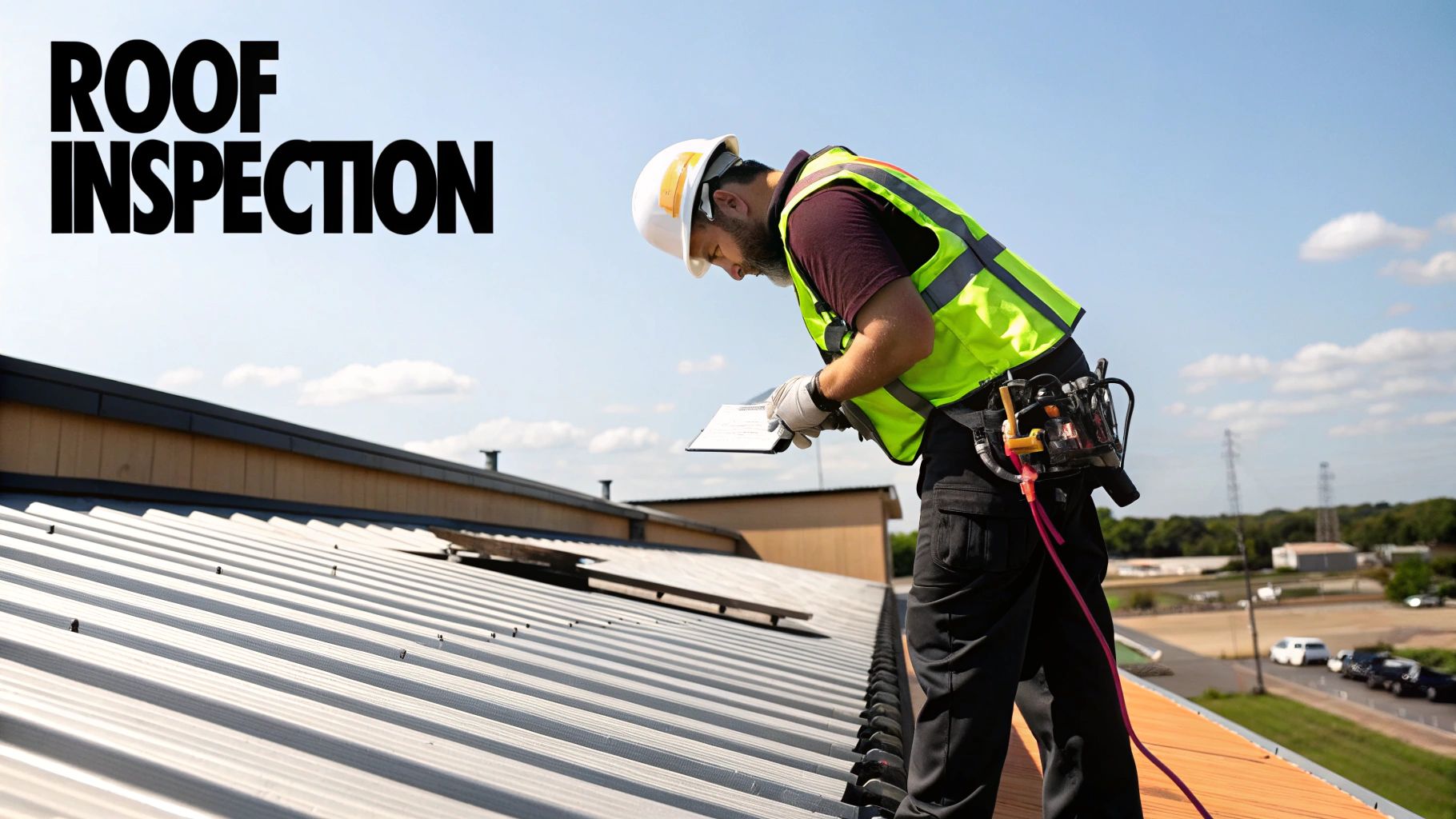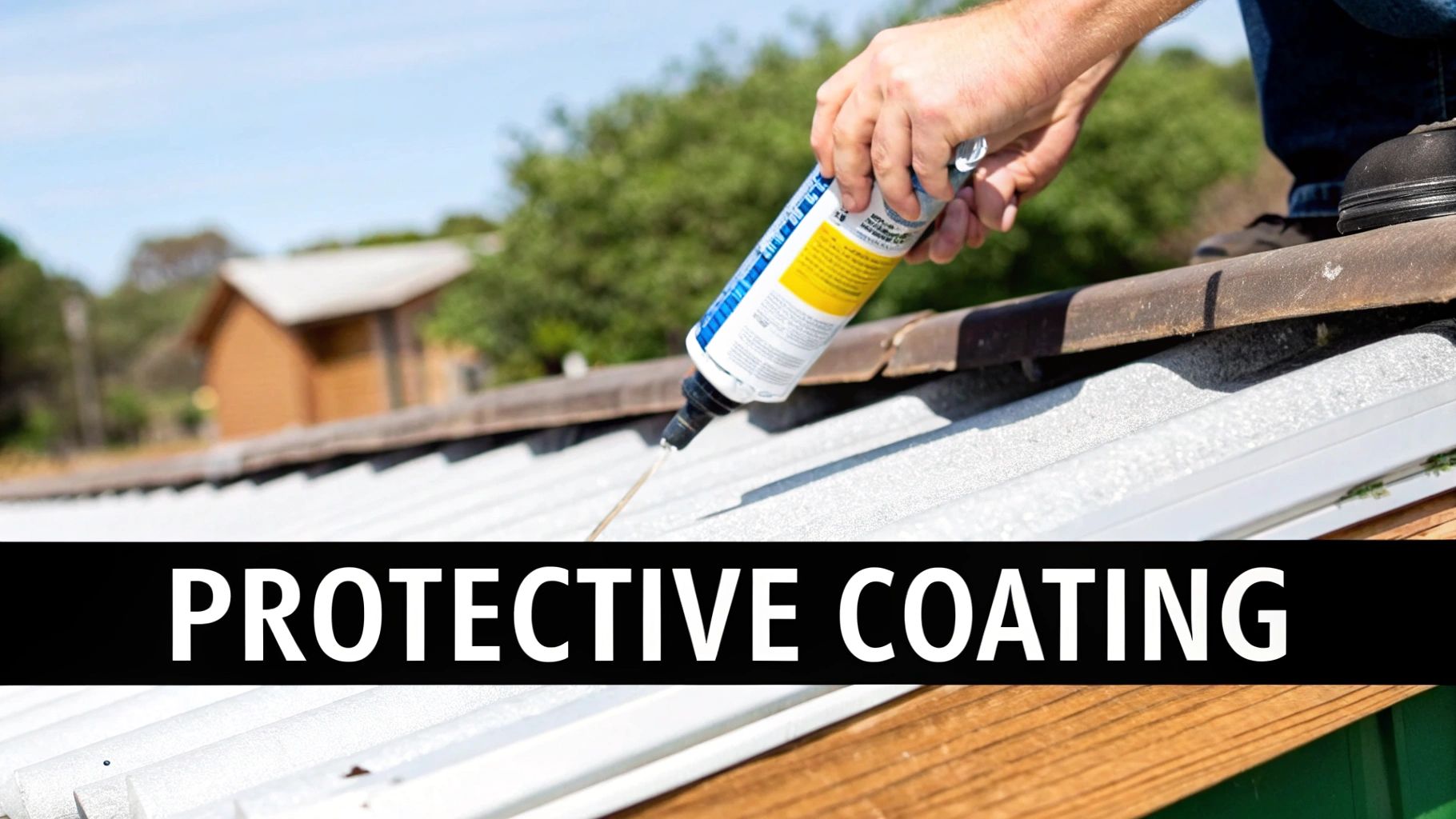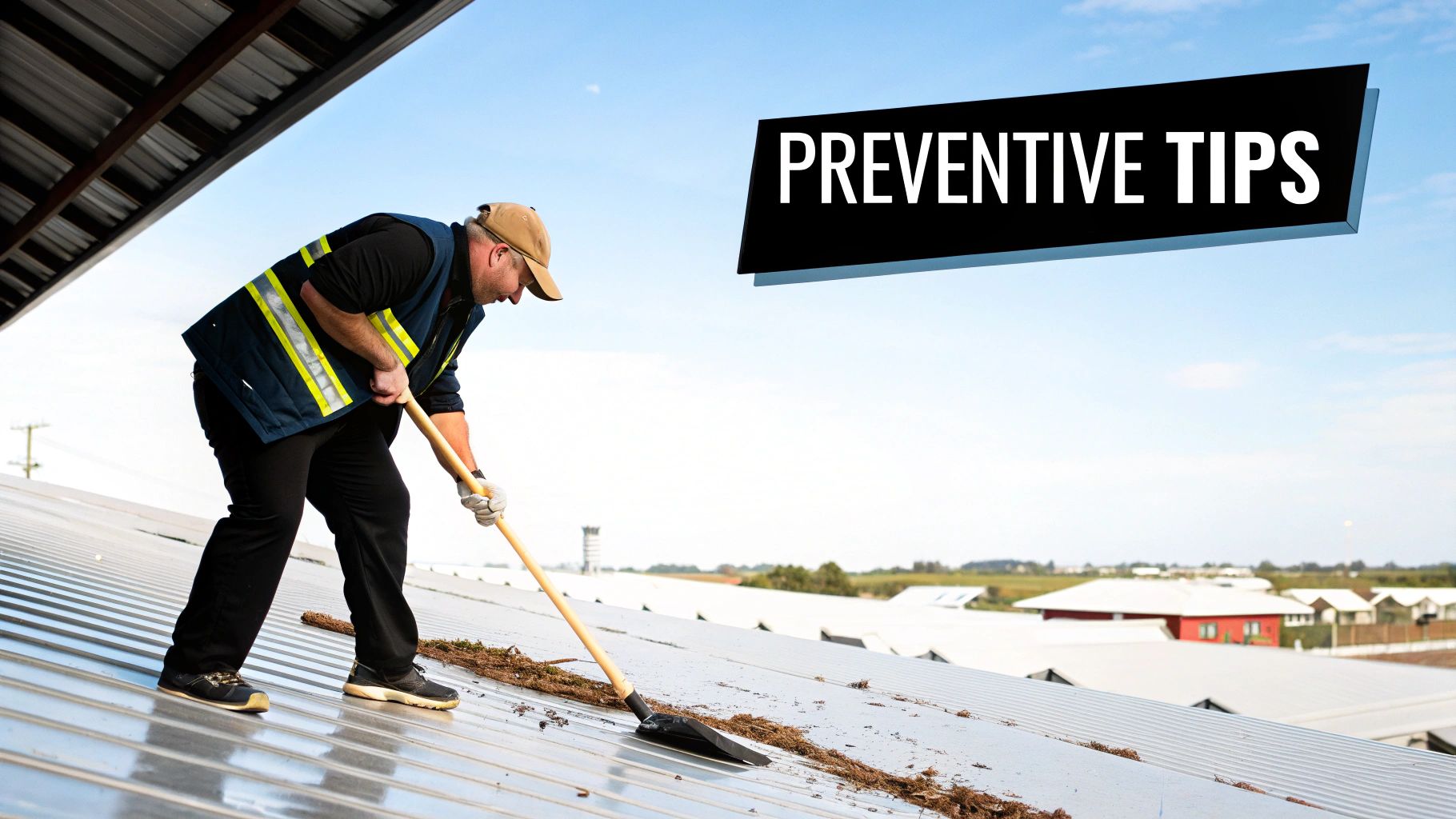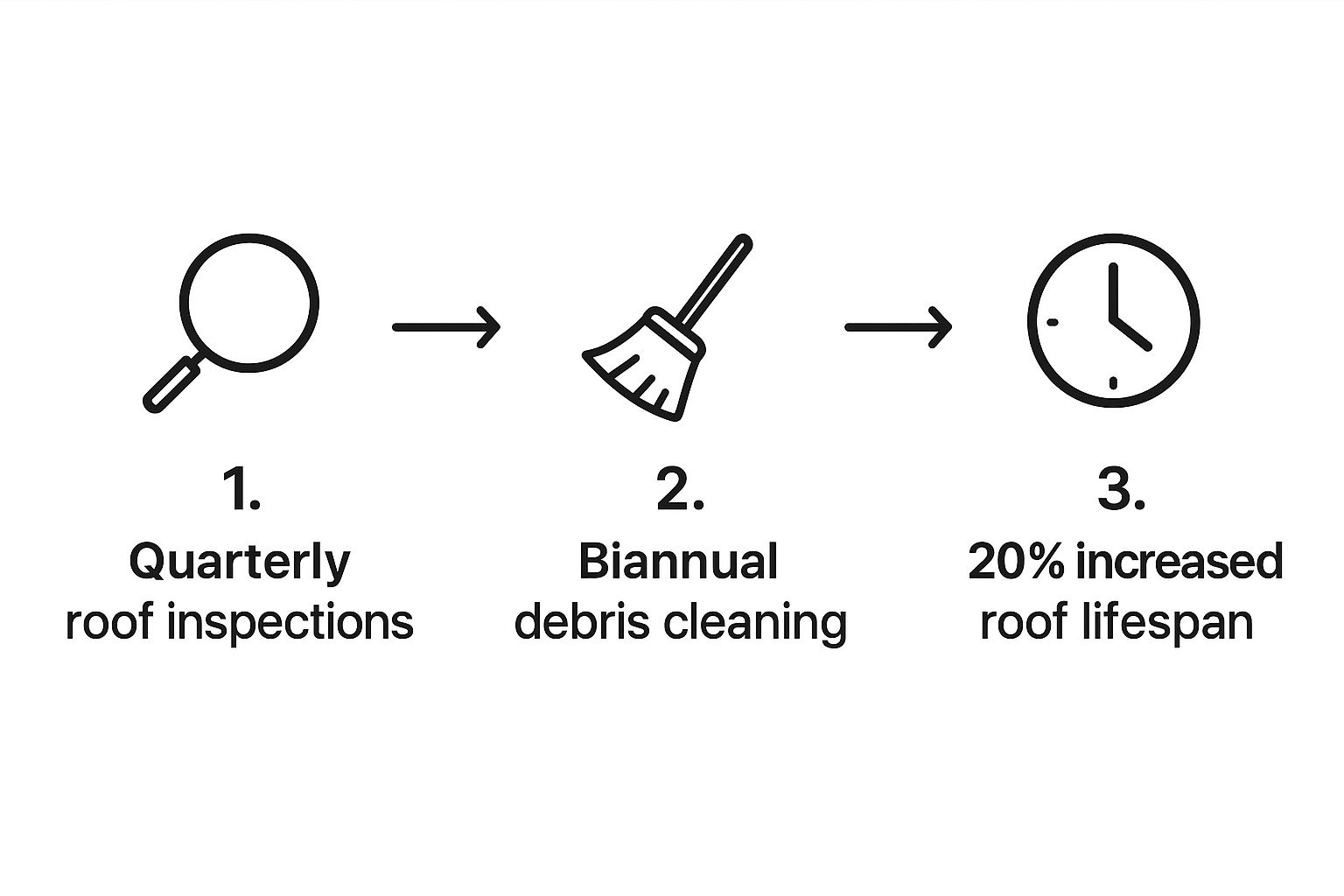When it comes to your metal roof, the old saying "a stitch in time saves nine" couldn't be more accurate. Thinking ahead with simple, regular checks is far and away the best way to make sure your roof lasts a lifetime. It's about catching small issues, like a few loose screws or a build-up of leaves in the gutters, before they snowball into serious headaches like water leaks and corrosion.

Why A Little Effort Now Saves A Lot Later
It's easy to see roof maintenance as just another job on the to-do list. But we encourage you to think of it as protecting a major investment—especially with the kind of weather we get here in Australia. A proactive mindset is genuinely your best line of defence against the elements causing premature wear and tear.
This doesn't mean you need to be up on the roof every weekend with a tool belt. It's more about getting into the habit of performing simple inspections, most of which you can do safely from the ground. This guide is all about giving you practical, professional advice to help you inspect, clean, and look after your roof, keeping it in top shape for years to come.
How Long Should a Metal Roof Really Last?
One of the biggest draws for metal roofing is its incredible longevity. Here in Australia, a well-maintained metal roof can easily last anywhere from 40 to 70 years, sometimes even longer. It really depends on the material you've chosen.
Of course, hitting these impressive lifespans doesn’t happen by magic. It's a direct result of consistent, proactive care. A little bit of neglect can chip away at that lifespan surprisingly quickly.
To give you a clearer picture, here’s how maintenance directly impacts the lifespan of common metal roofing materials in Australia.
Metal Roof Lifespan vs. Maintenance Effort
| Metal Type | Typical Lifespan (With Minimal Maintenance) | Potential Lifespan (With Regular Maintenance) |
|---|---|---|
| Colorbond® Steel | 25–40 years | 50+ years |
| Zincalume® Steel | 20–35 years | 45+ years |
| Aluminium | 30–45 years | 60+ years |
| Copper / Zinc | 60–80 years | 100+ years |
As you can see, the difference is significant. A bit of regular attention doesn't just add a few years; it can add decades of reliable performance.
From Minor Nuisance to Major Disaster
Let's think about a real-world scenario. A few gum leaves get caught in your gutter. It doesn’t seem like a big deal, right? But after a few weeks, more leaves pile up, creating a damp, heavy blockage. That trapped moisture is now sitting right up against your metal roof panels and fasteners, day in and day out. It's the perfect recipe for rust to take hold.
A single loose screw with a perished washer might seem insignificant, but during a heavy downpour, it can allow water to seep into your roof cavity, leading to hidden timber rot or stained ceilings. This is a classic example of how a five-minute fix can prevent thousands of dollars in repairs.
A forward-thinking approach allows you to spot these tiny problems while they're still easy and cheap to fix. This guide will walk you through what to look for, how to handle the simple tasks yourself, and when it’s time to call in the professionals. If you're interested in learning more about the fundamental advantages of this roofing material, have a look at our article on why to choose metal roofing.
Mastering Your Roof Inspection Checklist
Getting good at inspecting your own roof means you can catch small problems before they balloon into expensive headaches. This isn't about scrambling up a ladder every weekend. It's about training your eye to spot the tell-tale signs of trouble from a safe distance, giving your home's most important shield a regular health check.
A consistent routine helps you notice the subtle things. Think of the early, chalky discolouration on a panel that hints at a failing coating, or a fastener where the little rubber washer has finally given up. You'd be surprised what you can see from the ground with a decent pair of binoculars.
Ground-Level Visual Inspection
First things first, take a slow walk around the perimeter of your house. You want to get a good line of sight on every part of the roof. Pay special attention to the areas around vents, skylights, and chimneys – these penetrations are notorious weak points.
Here’s what our professional team scans for from down below:
- Debris Build-Up: Look for any pile-up of leaves, twigs, or dirt. This stuff loves to collect in the roof valleys, trapping moisture right against the metal. And moisture is the number one enemy.
- Obvious Damage: Can you see any bent, dented, or dislodged panels? A small ding from a gum nut is one thing, but a big dent from a fallen branch could mean the panel's integrity is compromised and needs a closer look.
- Corrosion or Discolouration: Scan the surface for any hint of rust or a strange, chalky film. A small spot of surface rust can usually be treated, but if you see it spreading, it’s time to call in a reliable roofing company, and fast.
- Gutter and Downpipe Condition: Check that your gutters are clear and hanging on tight. Stains on the fascia boards just underneath are a dead giveaway that your gutters are blocked and overflowing.
This quick walk-around should only take about 15-20 minutes. It's the safest and smartest first step you can take.
When a Closer Look Is Needed
Sometimes, you’ll spot something from the ground that just doesn't look right, and you'll need a better view. This is where safety has to be your absolute priority. Never, ever get on a roof when it's wet, icy, or windy. If you're not 100% confident with heights or working on a ladder, this is where your inspection ends and you pick up the phone to call a pro.
If you decide to proceed, make sure your ladder is on solid, level ground and extends at least a metre past the roof edge. Once you're up there, wear soft-soled, high-grip shoes to avoid scratching the panels and, more importantly, to keep your footing.
A classic point of failure on metal roofs is the tiny rubber washer under each fastener screw. After a decade baking in the harsh Australian sun, these washers go brittle and crack. This creates a perfect little pathway for water to get in. Finding and replacing these is probably one of the single most effective bits of preventative maintenance you can do.
While you're thinking about your roof's health, consider its performance too. If you’ve been noticing strange temperature swings inside, it could be a sign that your roof system isn't working as it should. To get a better handle on this, you can learn more about how to insulate a metal roof from our in-depth guide. Understanding these connections helps you know when to call for help, turning a small fix into a saved fortune.
Effective Cleaning and Debris Removal

A practical approach to cleaning is a cornerstone of maintaining a metal roof. Here in Australia, it’s not just a matter of washing away dust. The combination of sticky eucalypt leaves, bird droppings, and corrosive salt spray in coastal areas can create a damaging film that holds moisture against your roof's surface, accelerating wear and tear.
Keeping your roof clean isn’t just about looks; it’s about preserving its protective finish. The goal is to remove this harmful build-up without scratching the panels or compromising the coating that works so hard to protect your home. Fortunately, the best methods are often the simplest.
Choosing the Right Cleaning Tools and Solutions
The biggest mistake we see homeowners make is assuming more power is better. A high-pressure washer is one of the worst things you can use on a metal roof. The intense blast can easily force water underneath panel laps and flashings, potentially leading to leaks that go unnoticed inside your roof cavity. It can also dent softer metals and strip away the protective paint finish.
Instead, your best friends for this job are far gentler. Think of it like washing a car—you wouldn’t use a scourer on the paintwork.
- Soft-Bristled Brush: A long-handled, soft brush is perfect for gently dislodging dirt and grime without scratching the surface.
- Standard Garden Hose: A simple rinse with a regular hose nozzle is all the pressure you need to wash away loosened debris and cleaning solutions.
- Mild Detergent: A simple mix of water and a small amount of non-abrasive, pH-neutral detergent (like a gentle car wash soap) is all you need.
It's just as important to know what to avoid. Harsh, abrasive chemicals, scouring pads, wire brushes, and bleach-based cleaners will do more harm than good, and could even void your roof's warranty. Stick to gentle solutions.
The Critical Role of Clean Gutters
Cleaning the roof surface is only half the battle. Your gutters and downpipes are an essential part of the system, and neglecting them can have serious consequences. A clogged gutter or downpipe is one of the fastest ways to cause water damage.
We’ve seen this happen countless times. Just one downpipe blocked by a tennis ball and a handful of leaves. During the next heavy rain, the overflowing gutter channels water back under the eaves and directly into the ceiling cavity. A simple blockage can quickly lead to stained ceilings, damaged insulation, and even structural rot.
This is why regular gutter cleaning is a non-negotiable part of maintaining a metal roof. For most homes, a twice-yearly clean-out—once after autumn and again after spring—is enough to prevent these kinds of costly disasters. If you need a hand, trusting a reliable roofing company ensures the job is done safely and thoroughly, protecting your entire home from the top down.
Navigating Common Metal Roof Repairs
https://www.youtube.com/embed/b3vsjp93Rwk
When you own a property with a metal roof, one of the smartest things you can learn is what you can fix yourself versus when it’s time to call in the professionals. Not every little scuff or loose screw is a five-alarm fire. In fact, knowing how to handle the small stuff yourself will save you a heap of time and money, and it’s the best way to stop minor issues from snowballing into costly disasters.
Many simple repairs are completely doable for a handy property owner. Catching a small scratch in the paintwork early on is a perfect example. A quick touch-up is an easy weekend job that stops moisture from ever touching the metal, nipping rust in the bud before it even gets a chance to start.
Manageable DIY Fixes
Another common issue you'll likely run into is dealing with weathered or loose fasteners. After years of baking in the Aussie sun, the little rubber washers on your roofing screws can go brittle and crack. When that happens, the watertight seal is gone, giving rain an open invitation. Fortunately, swapping out a few of these tired old screws is a pretty straightforward task.
For these kinds of minor jobs, you won't need a truck full of gear. Your toolkit will be fairly basic:
- A tube of high-quality roof and gutter sealant that’s colour-matched to your roof.
- The right type of replacement screws, complete with new, integrated washers.
- A cordless drill fitted with the correct driver bit.
- A soft brush to clean the area properly before you start.
Knowing where to draw the line is just as critical as knowing where to start. If you’re looking at widespread rust beyond a few surface spots, or you can see the tell-tale signs of a stubborn leak, it’s time to put the tools down. Trying to patch up bigger problems without professional expertise can easily make things a whole lot worse.
When to Call a Reliable Roofing Company
Taking on major repairs yourself is a recipe for a much bigger headache. For instance, using the wrong sealant can actually react with your roof's coating and cause more harm than good. A dodgy patch job on a leak might just trap moisture underneath, leading to hidden corrosion that silently spreads across your roof sheets.
Even worse, a DIY repair gone wrong can void your manufacturer's warranty. That leaves you on the hook for what could become a very expensive professional fix later on.
The line in the sand is pretty clear. If the problem covers more than a few small spots, involves multiple panels, or you're chasing a leak you just can't pinpoint, it's a job for the pros. This is especially true for keeping metal roofs in top shape across Australia's tough and varied climates. From clearing gutters to replacing old fasteners, regular maintenance is the key to preventing corrosion and getting the most out of your roof.
This distinction between DIY and professional help is really the core of smart roof management. Understanding your limits protects your investment and ensures your roof can do its job for decades. For a deeper dive into specific problems, our post on common metal roofing repair scenarios has more detailed advice. The best roofing companies won't just slap a patch on the problem; they’ll find the root cause to give you a solution that lasts.
Choosing a Reliable Roofing Company

While a lot of metal roof upkeep is straightforward, some jobs are best left to the professionals. Knowing when to put the tools down and pick up the phone is a crucial part of smart homeownership. It's not just about safety; it’s about recognising when a problem needs an expert eye.
A reliable roofing company has the experience and diagnostic gear that you just can't match from the ground. We’ve seen it all before.
So, when is it time to call in the cavalry? If you’ve got a stubborn leak that shows up every time it rains, or you spot any sagging in the roofline, don’t try to be a hero. These are often signs of deeper issues that a quick patch-up won't solve. In fact, DIY attempts on complex problems can often make things a whole lot worse—and more expensive.
Vetting Your Roofing Contractor
The Australian roofing industry is massive, thanks in no small part to how popular durable materials like metal have become. That means you’ve got plenty of choice, but it also means not all companies are up to the same standard. To find a truly reliable roofer, you need to do a bit of homework. Think of it as hiring a guardian for one of your biggest investments.
Here are the critical questions we always recommend asking any potential contractor:
- Are you fully licenced and insured? This is the absolute first question. Ask for their licence number and a copy of their public liability insurance certificate. It’s your protection if anything goes wrong.
- Do you specialise in metal roofs? This is key. A roofer who mainly works with tiles might not understand the finer points of metal systems, from fastening patterns to the specific coatings. You want a specialist, not a generalist.
- Can I see some of your recent metal roof projects? A good company will be more than happy to provide references. Speaking to past clients is one of the best ways to gauge the quality of their work and service.
- What sort of workmanship warranty do you offer? This is completely separate from the manufacturer’s warranty on the materials. A solid workmanship warranty shows they have confidence in their own team and will stand by their repairs.
A workmanship warranty from an established, local company is worth its weight in gold. It means if a problem pops up because of the installation or repair, they’ll come back and fix it on their dime. That peace of mind is priceless.
The roofing services market in Australia is a big deal, which you can read more about in this market report from IBISWorld. This just goes to show how much homeowners are investing in quality roofing and why getting professional help is so important for protecting that investment.
Ultimately, picking the right roofer comes down to doing your due diligence. A little time spent checking them out now ensures your home's most important shield is in capable hands for years to come.
A Guide to Your Seasonal Maintenance Questions
When it comes to looking after your metal roof, a few common questions always pop up. Let's get straight into the practical answers you need to create a simple, effective maintenance routine that keeps your roof in top shape all year round.
Getting this right isn't just about ticking boxes; it's about extending the life of your investment.

The payoff for this consistency is huge. Small, regular efforts can add more than 20% to your roof's lifespan, making it one of the smartest things you can do for your home.
How Often Should I Clean My Metal Roof?
This is probably the number one question we hear. For most homes across Australia, a good, thorough clean every 18 to 24 months is a solid baseline.
However, your local environment is the real decider. If you live near the coast, that salt spray is incredibly corrosive and you'll want to wash it down annually. The same goes for homes surrounded by big, leafy gum trees that constantly drop debris. The goal is to get rid of anything that holds moisture against the metal, as that’s what leads to trouble.
When Should I Call a Professional?
Knowing your DIY limits is just as crucial as knowing what to look for. It's time to call in a roofing expert when you run into these situations:
- Safety First: If your roof is high, steep, or you simply don't have a head for heights, don't even think about it. It’s not worth the risk.
- Widespread Damage: A bit of surface rust is one thing, but if you're seeing large patches of corrosion, multiple loose panels, or damage from a serious storm, that's a job for the pros.
- The Mystery Leak: You’ve got a water stain on your ceiling but can't for the life of you find where it's coming from. A professional has the specialised gear and a trained eye to trace leaks back to their source.
A reputable roofer doesn't just slap a patch on it; they figure out why it happened in the first place and give you a permanent solution.
Can I Walk on My Metal Roof?
The short answer is: try to avoid it. Every step you take on a metal roof is a chance to dent a panel, scratch the protective coating, or loosen a fastener. It's surprisingly easy to cause damage if you don't know what you're doing.
If you absolutely must get up there, always wear soft-soled, grippy shoes. Make sure to walk on the flat 'pan' sections of the panels, and step directly over the battens or purlins underneath for support. This distributes your weight and minimises the risk of leaving a permanent dent.
Honestly, the safest bet is to do as much as you can from a sturdy, well-placed ladder. For any task that requires you to be on the roof itself, calling a fully-insured roofing company is the smart move. They have the proper safety equipment and know exactly where to step.
A simple, year-round schedule is the easiest way to stay on top of maintenance. Here’s a quick checklist to guide you through the seasons, ensuring nothing gets missed.
Seasonal Metal Roof Maintenance Schedule
This schedule outlines the key tasks to perform throughout the year. It's designed to be a simple, proactive way to keep your roof in prime condition and catch small issues before they become big, expensive problems.
| Season | Key Maintenance Tasks | Primary Focus |
|---|---|---|
| Autumn | Clear gutters and downpipes of leaves and debris. Trim overhanging branches. | Prevention. Removing blockages before the winter rains set in. |
| Winter | Visual inspection from the ground for any damage after storms. Check for loose panels or fasteners. | Damage Assessment. Addressing any storm-related issues promptly. |
| Spring | Thorough visual inspection for rust, corrosion, or peeling paint. Check all seals and flashings. | Condition Check. Assessing the roof's coating and seals after winter. |
| Summer | Schedule a professional clean if needed (every 18-24 months). Address any minor repairs found in spring. | Deep Clean & Repair. Preparing the roof for the year ahead. |
By following this simple rhythm, you can feel confident that your roof is getting the attention it needs to protect your home for decades.

